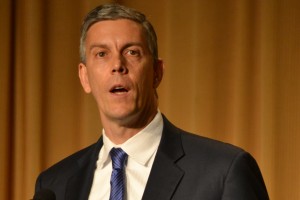
A kindergarten student at Gilbert Elementary School, Buena Park, CA.
Thousands of studies, hundreds of thousands of schools, and millions of teachers, decades of practice… you’d think we’d have school figured out by now, right? And in many ways, I think we do. It’s not mysterious work. For every problem in schools today, there are answers. We have plenty of models to learn from, to improve literacy and numeracy, to start project-based learning and service learning programs, to institute trauma-informed schooling, to educate students with special needs, to integrate technology, maker-spaces, engineering and design, to improve teacher induction and mentorship, to foster professional learning communities, to redesign teacher evaluation, compensation, and career pathways.
Seasoned educators, and certainly, National Board Certified Teachers, know that there are solutions to every challenge we face. So why aren’t schools, teachers, and students all fully functional and thriving yet?
There are some rather clear answers there as well.
- Expectations
- Focus and priorities
- Mission
- Politics
Expectations
Actions speak louder than words, and when it comes to educational expectations, legislative inaction betrays the hollowness of politicians’ words. They state that they expect every student to succeed, and no child left behind, an end to the “achievement” gap. Where they have the opportunity to act on expectations, we see instead deteriorating infrastructure, inadequate staffing, disrespect for the teaching profession, highly disparate funding levels for schools, and an unwillingness to even acknowledge the systemic racism that creates and ossifies the gaps. If they won’t acknowledge the cause of the problem, and the fact that whole industries are benefiting from the continuation of those problems, it’s hard to foresee the necessary transformations and increased investments needed to begin a restorative process.
Let’s be honest then. Few people in power genuinely expect transformative progress towards educational equity. Ignore their words. Look at their actions.
Focus and priorities
Despite the challenges at the state and national level, those of us working in schools do not throw our hands in the air and refuse to try to improve schools because legislators and other leaders fail to do their part. We carry on doing the best we can, focusing on what we can change, whatever is within our sphere of influence and control. And while I’ve taken a negative view of the broadest level of expectations around public education, there are many local communities, districts, administrators, support staff, and of course, teachers who are doing mostly good work most of the time.
Another obstacle that often arises is lack of focus. I began with the premise that we have the answers we need to provide a great education to every student, that every problem we know of can be solved. If only we could focus on one problem at a time. As teachers, we face the unique challenges of helping each student, in each unique classroom combination, at the same time that we try to advance our own professional learning, support colleagues, address school and district goals, master the curriculum and pedagogy we began learning in the past, and adapt to the newer, better, curriculum and pedagogy that just came along. I think it may be impossible to be a teacher and feel caught up with everything that needs to be done.
As individuals and as learning organizations, we need to prioritize based on our focus. However, prioritizing when we’re constantly stretched too thin is really more like triage. It seems like there are always some vital interests or services that are underserved. So, progress in one area requires us to postpone or neglect other important work, we actually begin to backslide in those areas, not for lack of understanding their importance, but rather due to insufficient capacity to address everything that should be at the top of our various lists.
Mission

A student changes a drill bit at Design39 Campus, Poway, CA.
We don’t even agree on what to put on those lists sometimes. If we hope to make collective progress in education, it would help to have consensus on the primary mission of the schools. Instead, our school improvement initiatives often have the potential to set off contentious debates. Some people argue that the school should focus on preparing the future workforce that will sustain and grow our economy, and of course, our future economic health is a vital concern. However, that particular focus tends to privilege certain voices and perspectives outside the school; the prescriptions of non-educators sometimes grate on the sensibilities of teachers whose view of students is more holistic, “whole-child” oriented, attending to the social and emotional development of students – not to the exclusion of concerns from higher education and business leaders, but not always in alignment either. Some educators might reasonably argue that some traits that are prized by colleges and employers are not necessarily in our students’ best interests. Should schools discourage social unrest and dissent, “keep a lid” on student protests, or rather, encourage the inclination to pursue liberty from institutions and systems that oppress? The answer might well depend on what you understand to be the mission of our school system.
Politics
I understand why education is so political, but unlike certain billionaires out there, I prefer democracy, with its messiness, over the alternatives in school governance. While elections introduce some potential instability when leaders and priorities change in a system, perhaps we can also mitigate the effects of political vacillations in education if we make stability an issue; school boards should empower those who work in the schools, trusting education professionals in administration and in classrooms to formulate and execute long-term plans for quality teaching and learning. That’s simply good governance.
Such empowerment cannot happen in a toxic environment, of course. At each level of our school systems, it’s up to leaders to safeguard the working environment of the people who depend on them. Teachers have the primary responsibility for the classroom environment of course. Then, a good principal absorbs many of the slings and arrows that might otherwise make teaching even harder than usual. A good superintendent should do the same for the site and district administrators. And a good board of education, while responsive to the community, should also uphold its responsibility to optimize rather than damage the relationships and environments that must be healthy in order to improve schools.

Former Secretary of Education Arne Duncan
When politics overrides good management, we see school climate suffer. No Child Left Behind was a perfect example. The goal of 100% proficiency for all of America’s students was never realistic. No goal that can be reached by everyone simultaneously is really worthwhile anyway. The 50 separate education systems of our semi-united states were never going to be endowed with the resources truly needed to reverse centuries of leaving many children behind. There was no intention of addressing the fundamental life differences that account for most of the results in students’ test scores. And how did we ever allow standardized test scores to become the measure of who is or is not left behind in the first place?
All of which is to say that politics is both necessary and often detrimental to our work in the classroom. When the politics go wrong, the negative impact on teachers and classrooms is considerable. We sadly find ourselves at times shifting from the pursuit of our best teaching to the pursuit of whatever is required for political cover, bureaucratic expediency, and even, in a nearly literal sense, necessary for our survival.
We do know what to do to improve education. It’s not difficult–to know what to do. Sadly, it seems almost impossible to align our stars and make it happen in a widespread, sustained, and equitable manner. So we are left with a number of paradoxes. There’s no better alternative than to keep trying to move urgently in the right direction, while at the same time, we need to avoid burning out because we had unachievable hopes of rapid and radical change. We must always push ourselves to improve through frank assessments, analysis, and reflection on our work, while at the same time, we must hold off the critics who don’t have our best interests at heart, who set us up to fail and say we’re making excuses when we point that out. Staying #NBCTstrong means we understand the cross-currents that challenge our profession and our students, and we carry on as teachers and leaders, determined to effectively navigate through it all.
This blog post was written for and first published by The Standard, a group blog for the National Board for Professional Teaching Standards.

So true! I have watched this play out in so many different settings. The other factor is fear…fear of change..fear of admitting that what you’re doing may not be enough…fear of giving up the tried and true for the unknown. Julie Wilson wrote an interesting book, The Human Side of Change in Education, about it.